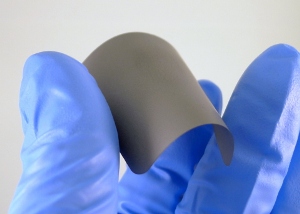Dec 10 2014
Enevate Corporation, a leading developer of advanced rechargeable Lithium-ion (Li-ion) batteries, announces HD-Energy® Technology for Li-ion batteries. Enevate’s HD-Energy Technology enables high energy density rechargeable Li-ion polymer cells using a novel silicon-dominant composite anode that has four times the energy density of conventional graphite anodes.
 Enevate's HD-Energy Anode consisting of 100% active material is flexible and monolithic, enabling a new generation of high energy density Li-ion batteries for mobile devices. (Photo: Business Wire)
Enevate's HD-Energy Anode consisting of 100% active material is flexible and monolithic, enabling a new generation of high energy density Li-ion batteries for mobile devices. (Photo: Business Wire)
Enevate Corporation, based in Irvine, California, is focused on delivering advanced Li-ion batteries into smartphones, tablets, ultra-thin/hybrid notebook PCs, and wearable devices, delivering significantly higher energy density in thinner form factors to enable longer runtimes in less space.
“Enevate is using a unique technical approach for silicon anodes that is truly different and innovative to deliver high energy density Li-ion batteries,” said Dr. John Goodenough, recipient of the US National Medal of Science who helped invent the Li-ion battery, and Professor of Material Science at University of Texas-Austin. “I’m impressed that their technology and process is practical, highly manufacturable, and can be sufficiently inexpensive for high volume consumer electronics.”
Developed from several years of original research work, Enevate’s novel HD-Energy Technology utilizes silicon-dominant composite anodes for rechargeable Li-ion polymer batteries which dramatically increase energy density over conventional graphite anode cells. While conventional graphite anodes can store 372 mAh/g, pure silicon through an alloying process has the potential to store up to 4200 mAh/g. The self-standing, flexible, and conductive anodes are comprised of majority silicon in a complex micromatrix composite that is 100% active and contains no inactive or “dead space” binders and is engineered for high volume manufacturing. The HD-Energy Technology delivers a high capacity monolithic or “single-particle” anode which enables cell designs today up to 700-800 Wh/L core energy density with cycle life similar to graphite cells. Competitive approaches using silicon nanowires or nanoparticles are difficult and expensive to manufacture in high volume. Others using silicon oxide (SiO) as a dilute additive in graphite anodes do not deliver enough performance improvement.
“We have developed very high energy density Li-ion cells for mass production with our new HD-Energy Technology utilizing silicon-dominant anodes,” said Dr. Benjamin Park, CTO of Enevate. “This new and different approach allows us to realize a roadmap to over 1000 Wh/L volumetric energy density which is very exciting to differentiate mobile consumer applications.”
“Imagine what can be achieved with four times the energy density in smartphones and other mobile devices,” said Jarvis Tou, Executive Vice President of Marketing and Products at Enevate. “A sleek product design with a significant increase in energy creates opportunities for energy-intensive features like new software capabilities, better displays, always-on sensors, improved cameras, faster connectivity, and increased performance.”
Enevate’s custom cell designs using HD-Energy Technology also have very low AC impedance or internal resistance, typically less than half that of graphite cells. Utilizing available cathodes, separators, and electrolytes in today’s Li-ion ecosystem, Enevate’s Li-ion batteries are designed to meet UN, UL, and CTIA safety certifications. Enevate’s HD-Energy Technology delivers combined attributes ideal for use in sleek mobile devices to deliver more runtime, enable new energy-hungry features, and allow for thinner product designs.